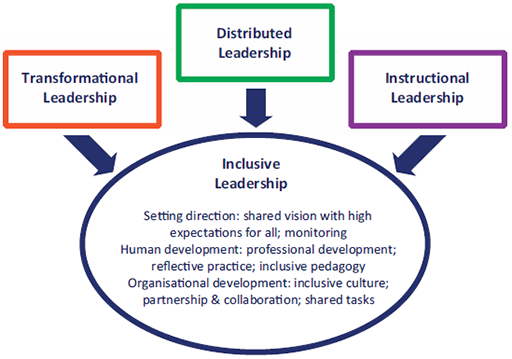2 Mindset and models for inclusive leadership
The EU project mentioned above conceptualised inclusive leadership by drawing upon three main theories of school leadership linked to successful inclusive practices: instructional leadership, transformational leadership and distributed leadership. Historically, such models have been seen to operate in contrast to each other. Instructional leadership models, for example, emerged in the 1970’s with a focus on three activities: Defining the School Mission, Managing the Instructional Programmes, and Creating a Positive School Climate (Hallinger & Murphy, 1985); whilst transformational leadership came to the fore in the 1990’s, and has been represented by four dimensions: Idealized Influence, Inspirational Motivation, Intellectual Stimulation, and Individualized Consideration (Bass & Avolio, 1995). However, it has also been recognised that adopting the two models can have a moderating effect on student outcomes. Kwan (2020), for instance, in a large scale study in Hong Kong secondary schools, suggests that transformational behaviour is a necessary condition for effective instructional measures.
Óskarsdóttir et al (2020) draw upon a wide range of literature to outline the three theories underpinning their inclusive leadership model:
They talk about instructional leadership as involving the setting and communication of clear goals and expectations for instruction. It involves the development, planning and coordination of the curriculum, all the time seeking to enhance the quality of teaching and learning in the classroom. There is a focus too upon evaluating teachers and teaching, whilst promoting and improving measurable outcomes for learners, and at the same time creating a supportive, encouraging work environment, that enables the development of teaching practices that improve academic performance. This involves coordinating the efforts of teachers and teacher-leaders to support each other and the school mission, leading to more collaboration and reflective dialogue between teachers, greater recognition of their innovation and more positive interactions between teachers and learners.
In discussing transformational leadership, they identify inspiring others as central to its practice, building a shared vision and providing support that facilitates change and innovation through impacting people and cultures within schools. The focus is upon developing both a collaborative culture and the people within the school, (re)designing the organisation to establish structures and ways of working that enhance the quality of teaching and learning. The aim is to give adequate support, that influences school staff so they become highly engaged and motivated, so they are inspired by goals they believe in and feel are aligned with their values. Clearly, leaders need to identify which values are critical to the performance of their staff and need to focus on practices most likely to have a positive influence on those values. All of this means the ability to be transformative depends upon their analysis and understanding of the school’s needs and priorities.
In considering distributed leadership, they note that the emphasis is on collaborative efforts which are in turn based on a network of relationships between people. They suggest that at the core of this are people’s social ties and the trust that arises from these. The consequence of this social capital is evident in the benefits and resources which emerge for the organisation and the people who are within it. Consequently, the aim is to draw on the collective talent and capacities within the school, connecting people in meaningful and productive ways, whilst facilitating the sharing of knowledge and skills. This means there is a focus on the development of others, on the sharing of responsibility across leadership teams, and on the interactions between people in formal and informal leadership roles. This includes devolving responsibility to middle management teams and seeking to organise everyone to be flexible, to share practice and to take responsibility for change. Anyone can be a driver of the change process, multiplying the head teacher’s actions.


